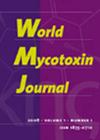New trends for the efficient bio-degradation of food contaminant zearalenone using a plant rhizobacterial strain: an in-vitro study
IF 1.7
4区 医学
Q3 FOOD SCIENCE & TECHNOLOGY
引用次数: 2
Abstract
Zearalenone (ZEN) is one of the most damaging and well-known toxins present in foods and animal feeds throughout the world. Klebsiella pneumoniae strains isolated from maize roots through soil samples were able to completely remove ZEN from LB medium after a 72-h fermentation through the enzymatic degradation and absorption of the toxin. The removing properties, including ZEN concentrations, incubation pH, incubation temperatures, bacterial concentrations, culture supernatant, and cell wall effect on degradation were evaluated. The K. pneumoniae strain culture supernatant has a strong ability to remove ZEN, and the degradation rate was more than 70%. The cell wall also has a certain ability to remove ZEN up to 18.51%, while the bacterial content has almost 5.61% ability to degrade ZEN. The removal rate and degradation metabolites alpha/beta-zearalenol, alpha/beta-zearalanol, zearalanone, and ZEN-sulphate were evaluated and confirmed by High Performance Liquid Chromatography (HPLC) and Ultra-Performance Liquid Chromatography Tandem Mass Spectrometry analyses. The mechanism of ZEN and its derivatives degradation by this bacterial strain will be further studied so that novel degrading enzymes can be isolated which can be used as bio-detoxifier.利用植物根菌菌株高效生物降解食品污染物玉米赤霉烯酮的新趋势:体外研究
玉米赤霉烯酮(ZEN)是世界各地食品和动物饲料中存在的最具破坏性和众所周知的毒素之一。通过土壤样品从玉米根中分离的肺炎克雷伯菌菌株经过72小时的酶降解和毒素的吸收,能够从LB培养基中完全去除ZEN。对ZEN浓度、孵育pH、孵育温度、细菌浓度、培养上清液和细胞壁对降解的影响等去除性能进行了评价。肺炎克雷伯菌培养上清液对ZEN的去除能力强,降解率达70%以上。细胞壁对ZEN也有一定的去除能力,可达18.51%,而细菌含量对ZEN的降解能力约为5.61%。采用高效液相色谱(HPLC)和超高效液相色谱串联质谱(Ultra-Performance Liquid Chromatography Tandem Mass Spectrometry)分析了玉米醛烯醇(α / β -玉米醛醇)、玉米醛烯醇(α / β -玉米醛醇)、玉米醛烯酮和zen -硫酸盐的去除率和降解产物。今后将进一步研究该菌株降解ZEN及其衍生物的机理,以分离出新的降解酶作为生物解毒剂。
本文章由计算机程序翻译,如有差异,请以英文原文为准。
求助全文
约1分钟内获得全文
求助全文
来源期刊

World Mycotoxin Journal
MYCOLOGY-
CiteScore
4.60
自引率
5.00%
发文量
25
审稿时长
>12 weeks
期刊介绍:
''World Mycotoxin Journal'' is a peer-reviewed scientific journal with only one specific area of focus: the promotion of the science of mycotoxins. The journal contains original research papers and critical reviews in all areas dealing with mycotoxins, together with opinions, a calendar of forthcoming mycotoxin-related events and book reviews. The journal takes a multidisciplinary approach, and it focuses on a broad spectrum of issues, including toxicology, risk assessment, worldwide occurrence, modelling and prediction of toxin formation, genomics, molecular biology for control of mycotoxigenic fungi, pre-and post-harvest prevention and control, sampling, analytical methodology and quality assurance, food technology, economics and regulatory issues. ''World Mycotoxin Journal'' is intended to serve the needs of researchers and professionals from the scientific community and industry, as well as of policy makers and regulators.
 求助内容:
求助内容: 应助结果提醒方式:
应助结果提醒方式:


